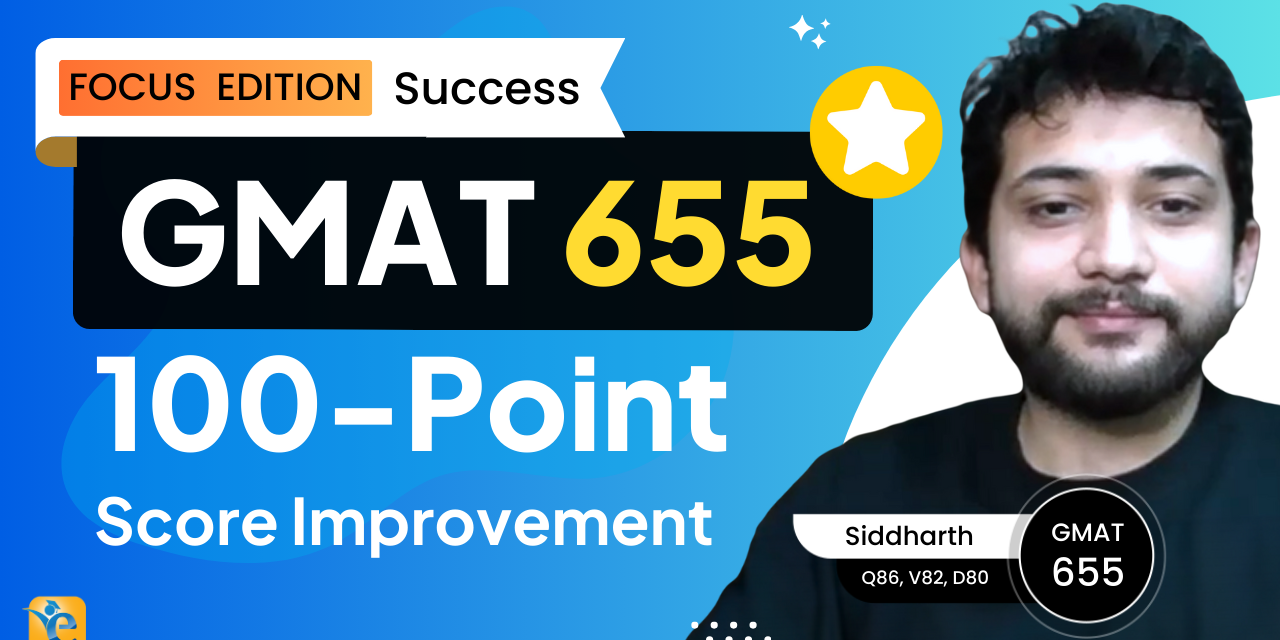Introduction
In the competitive world of GMAT preparation, where every point can be the difference between your dream MBA program and the next best option, Siddharth Suvarna’s story stands out as a beacon of determination, strategic planning, and execution. A Computer Science Engineer with five years’ experience as a Software Engineer, Siddharth started his preparation for the GMAT Classic Edition with a diagnostic score of 600. His initial score, translating to a 51st percentile ranking or a 555 equivalent on the GMAT Focus Edition, was a modest beginning for someone with his ambitions. However, Siddharth’s unwavering commitment to improvement saw him eventually soar to a 655 on the GMAT Focus Edition— this GMAT Focus Success with a remarkable 100-point improvement that catapulted him into the 90th percentile, a testament to his hard work and strategic approach to the exam.
This article dives into Siddharth’s GMAT preparation journey, shedding light on the challenges he faced, the strategies he employed, and the insights he gained as he elevated his Verbal score from a 58th percentile to an impressive 80th percentile, his Quantitative score from the 43rd percentile to the 92nd percentile, and his Data Insights score to a D80, the 86th percentile. His story is not just a narrative of personal achievement but a guidebook for GMAT aspirants worldwide, offering valuable lessons on discipline, persistence, and the strategic use of e-GMAT’s resources to conquer this challenging examination.
In this article, we explore the following aspects of Siddharth’s journey:
- Overcoming Early Challenges with Discipline – Learn about Siddharth’s struggles with consistency owing to working in the “Graveyard Shift”, and how a disciplined approach turned his preparation around.
- Quantitative Leap – Uncover the strategies that propelled Siddharth from the 43rd to the 92nd percentile in Quant, demonstrating that even small mistakes can be overcome.
- Verbal Victory: Building a Strong Foundation – Explore how e-GMAT’s “Master Comprehension” course and “Pre-thinking” laid the groundwork for Siddharth’s significant improvement in Verbal to a V82.
- Navigating Data Insights with Precision – Dive into Siddharth’s approach to Data Insights, where applying Verbal Reasoning Skills played an instrumental role in improving his score to a D80.
- Cementing, Scholaranium, and Data Analytics: Precision Tools for Improvement – Siddharth shares how reinforcing concepts through Cementing Quizzes ensured a smooth transition between subsections, provided crucial insights into his preparation, and boosted his confidence immensely.
- Last Mile Push & Mock Exams: A Tailored Study Plan – Learn about the final three-week study plan that helped Siddharth achieve surgical precision in his Test Readiness and Mock scores.
So, let’s dive in!
Overcoming Early Challenges
Juggling a demanding job in the Pacific timezone, Siddharth faced the daunting task of integrating a rigorous study schedule into his already packed routine. Consistency in study habits, often a stumbling block for many aspirants, emerged as his first major hurdle.
Initially, Siddharth’s preparation was geared towards the GMAT Classic edition. Unaware of the GMAT Focus edition, his preparation journey took a significant turn when he discovered and switched to the newer format. This switch, while beneficial in the long run, extended his preparation time due to the need to adapt to a different study approach and content focus.
Furthermore, work commitments intermittently pulled him away from his studies, introducing weeks-long breaks that tested his resolve and consistency.
The turning point came when he embraced the importance of discipline and a structured routine in GMAT preparation. Siddharth credits Payal’s onboarding webinar as a pivotal resource in reshaping his approach to the exam. The webinar, which detailed how to prepare diligently, the sacrifices required, and how to craft an effective study plan, proved to be instrumental. “It helped immensely,” Siddharth recalls, highlighting the impact of adopting a disciplined approach to his studies.
Quantitative Success Strategies
Scoring a Q86, which is equivalent to the 92nd percentile or a Q50 in the traditional GMAT format, Siddharth leveraged his strong math background to overcome what he identified as not conceptual gaps, but rather, the propensity to make “that one silly mistake.” Whether it was a simple oversight in addition or subtraction, or not considering all cases due to timing pressures, these errors were the bane of his early attempts.

The breakthrough came with the disciplined use of the e-GMAT process skills and error log, a tool he used to meticulously track his performance. “It helped me remember to apply the process skills,” Siddharth explains, emphasizing the importance of this reflective practice.

Siddharth defines a Process Skill as an essential element in solving Quantitative questions correctly. For instance, the process skill “infer” helped him delve deeper into question stems and answer choices. “Are you inferring the question correctly? Are you considering all cases? Did you misinterpret the answer choice?” These questions became a mantra for Siddharth, aiding him in navigating the pitfalls of misinterpretation and oversight.
Verbal Preparation Insights
“Everyone doing e-GMAT verbal should start with Master Comprehension,” Siddharth advises, underscoring the significance of understanding the basic building blocks of sentences and techniques like “Strategic Pausing” to enhance their comprehension skills. This ability played a crucial role in enhancing his performance in Critical Reasoning (CR) and Reading Comprehension (RC) to finally achieve a GMAT Focus Success.

This foundation was particularly effective in avoiding common traps set by closely worded incorrect answer choices and managing the timing challenges inherent in the verbal section.

In addition to MC, Siddharth credits the “pre-thinking” technique as a game-changer in his verbal preparation, especially for CR questions. Pre-thinking, as he describes, is about anticipating the answer before even glancing at the options provided. “It made a huge difference to my prep—to the point that now I automatically begin to pre-think assumptions the moment I read an argument,” he shares. This proactive strategy improved his accuracy by narrowing down the answer choices more effectively. Pre-thinking was not a one-size-fits-all approach but a nuanced strategy tailored to different question types.

When dissecting boldface questions, the ability to preemptively map out the structure of an argument and its components significantly bolstered his performance. “Is it a conclusion, is it evidence? Is it a claim or a fact?… Eventually, you would come to a point where you’d do this naturally in CR,” he reflects on his progression towards a GMAT Focus Success.

Navigating Data Insights (D.I.)
The D.I. section, known for its stringent time constraints and the unforgiving nature of its scoring system—where a single error in a set can nullify all correct answers—demanded a tactical approach. “Didn’t expect I’d have to apply all my verbal skills in DI,” he admits, highlighting the integral role of reading comprehension in navigating this quantitatively titled section. The dense information and complex datasets in MSR and TPA sections not only required a keen analytical mind but also an ability to swiftly comprehend and synthesize information from multiple sources.

To mitigate the risk of running out of time, Siddharth employed a strategic yet somewhat unconventional method for handling the time-intensive MSR questions. He initially marked answers randomly to ensure that every question had a response, thereby avoiding the penalty of unanswered questions. This approach allowed him the flexibility to return to the dataset and refine his answers as time permitted. “Because MSR takes a long time, there’s a high chance we might run out of time and be unable to mark anything before the clock runs out,” he explains, justifying his strategy to preemptively mark answers as a safeguard against the clock.
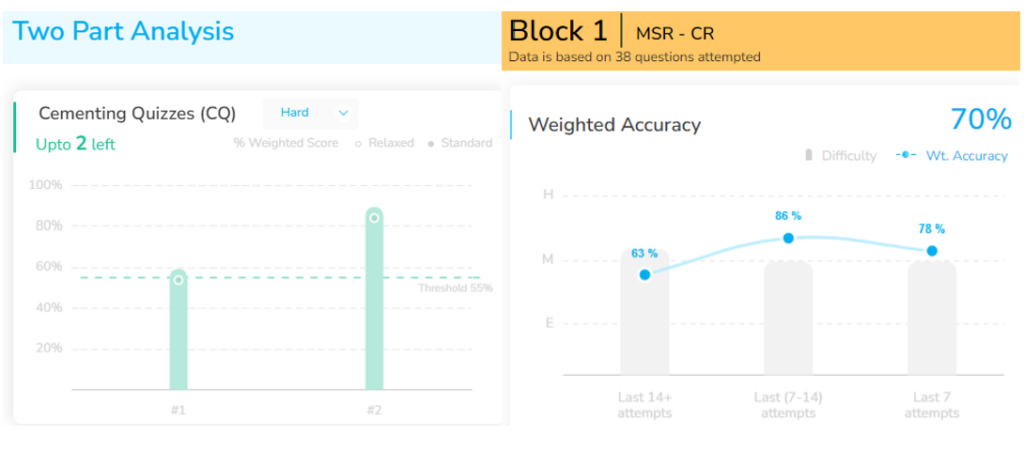
Cementing Quizzes
“Cementing is that bridge when you’re moving from one subsection to the next. It gives you that guarantee that you know how to apply the concepts you’ve learnt in a subsection,” Siddharth explains, highlighting the critical role of cementing quizzes in his preparation.

Cementing involves overcoming two challenges: first, the recollection of concepts, and second, their practical application. Moreover, he emphasizes the reality check provided by cementing quizzes. “It’s a confidence-booster,” he remarks, acknowledging how these quizzes help dispel overconfidence and correct any misconceptions about one’s mastery of the material.
Ready to tackle the GMAT Focus Edition? e-GMAT offers a Personalized Study Planner and top-notch Free GFE mock exam to help you prepare effectively. As the most reviewed GMAT prep company on GMAT Club with 2600+ reviews we’re here to support your GFE journey. Take advantage of our free trial with the best quality content. Start your path to success today!
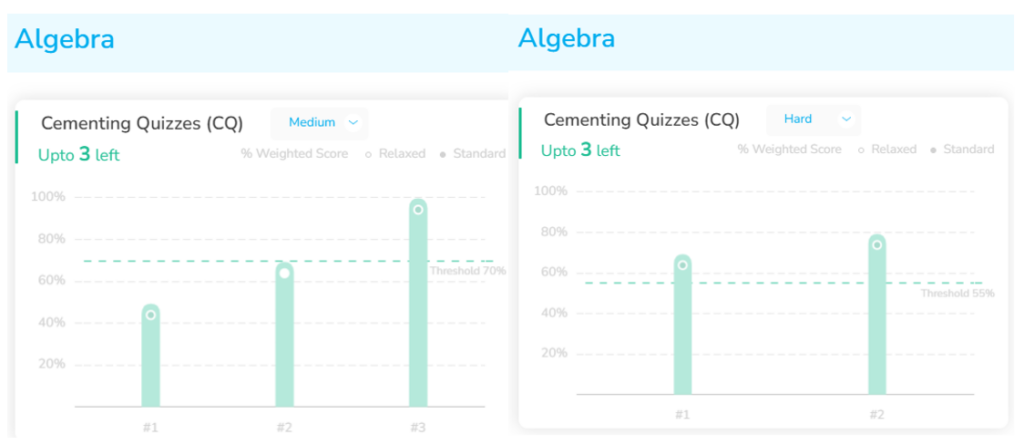
Furthermore, Siddharth credits the data analytics from these quizzes as pivotal in identifying areas of weakness. For instance, in Critical Reasoning cementing quizzes, the inclusion of various question types—from assumptions to boldface—enables a detailed analysis of strengths and areas needing improvement. “It’s all very precise and granular,” he says.
Scholaranium and Data Analytics
Scholaranium, e-GMAT’s testing platform, combines practice questions with detailed data analytics. Siddharth valued Scholaranium not just for the volume of questions it offered but for the quality and the insight it provided into his readiness. “The first thing about Scholaranium I’ve noticed is that you don’t need to solve a whole lot of questions to master a section or a subsection. It makes you realize where you are by giving you all the data,” Siddharth remarks, emphasizing the efficiency of preparation it afforded him.

A standout feature of Scholaranium, according to Siddharth, was the difficulty level of its questions. “Scholaranium questions are pretty tight. They may be a little tougher than the actual GMAT,” he observes, adding that this rigor is beneficial as it prepares students for the exam more effectively. And, the tool’s ability to pinpoint specific areas for improvement, such as Number Properties in Siddharth’s case, allowed him to focus his study efforts more strategically.

“If you look at the bar graphs and the trend plots, it becomes very easy to spot the areas you need to work on,” he explains, appreciating the clarity it brought to his preparation.


Furthermore, “Your Scholaranium makes it pretty easy to identify what challenges you faced earlier… You just have to go into your attempts data and everything is right there,” he notes, highlighting the ease with which one can review and reinforce learning.

Mock Exams and Test-Taking Strategy
e-GMAT’s philosophy is that mocks are not for learning concepts but for confirming readiness. “The real improvement happens in the 3 stages of learning…mocks are mainly just to confirm that you’re indeed ready for the test,” he explains, suggesting that two or three mocks are sufficient for this purpose.
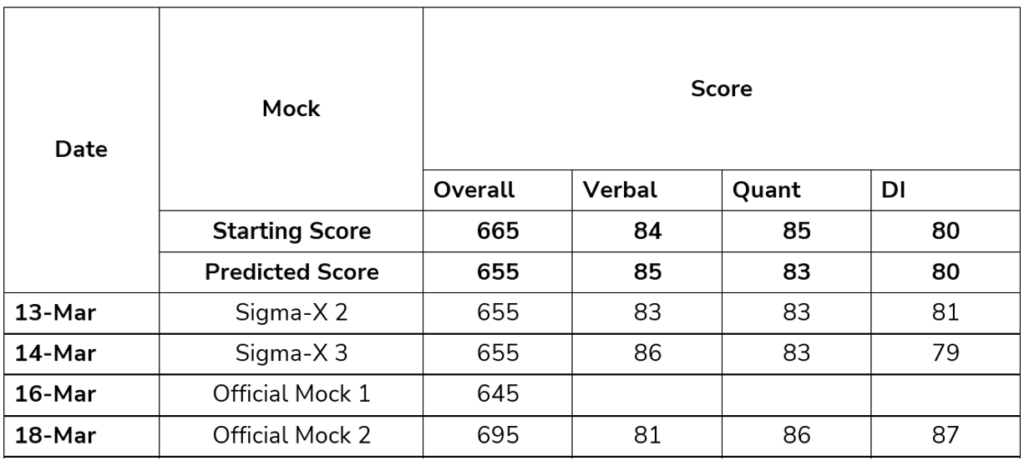
Once again, e-GMAT’s Sigma-X mocks consistently predicted Siddharth’s final score a lot more accurately than the Official Mocks.
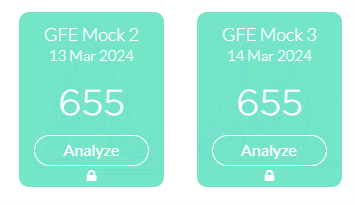
Transitioning from a multitasking work environment to the singular focus required for a 2-hour and 15-minute exam was a significant adjustment. “It’s been over 8 years since I concentrated on just one thing for so long,” he shares.
A critical aspect of his mock exam strategy involved managing time constraints and making tough decisions on question prioritization. Siddharth developed a strategy to skip questions that took longer than 3 minutes, recognizing the opportunity cost of spending too much time on a single question. “The GMAT is going to serve you tough questions, you need to bookmark them and come back to them later,” he advises.
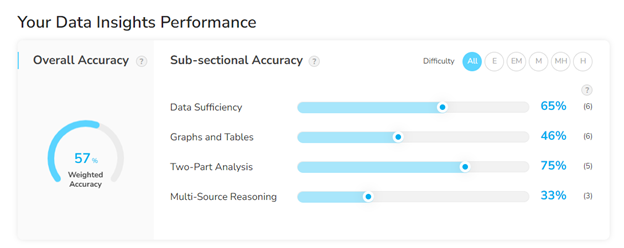

He praises the SigmaX mocks for their realism and their role in strategy development. “SigmaX mocks prepare you for the worst…I was able to identify fairly quickly that I was facing a timing issue rather than a conceptual issue,” Siddharth notes. His strategic choice of section order—DI -> Verbal -> Quant—was tailored to his strengths and energy levels throughout the test which eventually helped him to reach his GMAT Focus Success.

Siddharth also emphasizes the importance of mock exam analysis, including reviewing correct answers to ensure they were solved efficiently and for the right reasons. “If there is an easier way to solve the question, the GMAT and e-GMAT want you to take the easier and faster way,” he explains.

Last Mile Push: Tailored Study Plan
In the crucial final three weeks leading up to the GMAT, Siddharth preparation entered its most intensive phase, characterized by study targets meticulously set with specific improvements in mind: a 2-point increase to achieve a D80 in Data Insights, enhancing his Quant score to Q86, and maintaining his Verbal score at V82. Achieving these exact targets, Siddharth’s final scores were a testament to the effectiveness of this laser-focused approach. “This level of precision is unparalleled, and the study plan and the final scores speak for themselves,” he reflects on the impact of his final preparation phase.
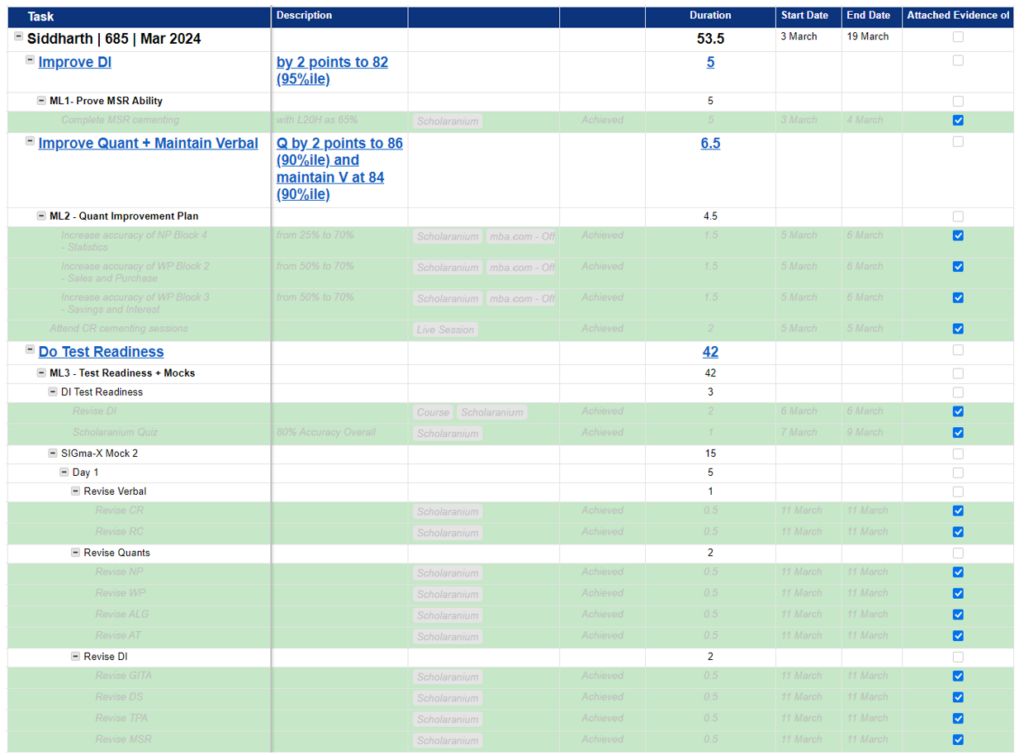
Siddharth candidly discusses the dwindling enthusiasm and mounting exhaustion that many test-takers face as the exam date approaches. The tailored study plan, provided by his mentor Akash and the e-GMAT team, played a crucial role in navigating this challenging period. “If it were left to me, I probably wouldn’t have executed each of these steps,” Siddharth admits, highlighting the importance of external guidance and the personalized analysis that informed his study plan.
“Having that sheet in which I know if I do this, I’m going to improve my score, helped me a lot,” he shares, appreciating the clarity and direction this provided.
Moreover, the ability to discuss preparation challenges with someone who understands the process alleviated the stress and isolation often associated with GMAT preparation to finally achieve GMAT Focus Success. “Have faith in the e-GMAT team, they’re rooting for you. They have your back!” he advises, emphasizing the value of trust and communication in overcoming the psychological hurdles of preparation.
Final Tips and Conclusion
In offering his final pearls of wisdom to future GMAT aspirants, Siddharth Suvarna emphasizes a blend of trust in the preparation process and the importance of self-research. “Have faith in e-GMAT. I would go with e-GMAT,” he advises, while also cautioning against blind trust. “Do your research. Read the e-GMAT blog. Watch their interviews…They have a process for everything, right from the start, to your final leg.”
Highlighting the significance of the onboarding video, Siddharth says, “It helps you understand what mindset you’re going to require.”
Reflecting on his own experience, Siddharth acknowledges the constraints posed by time and life’s other commitments. “GMAT is one of those tests where I have learnt to deal with life while preparing for the exam,” he shares, offering a sense of solace to those who might feel overwhelmed by balancing preparation with other responsibilities.
“In the beginning, it might not make sense, but within 6 months, everything will fall in place. So, keep the faith,” he counsels, emphasizing the non-linear nature of learning and improvement. Click here to watch what Rajat & Payal had to say about non-linearity of learnings and outcomes in one of our Coffee Sessions.
“Accepting that the graph is non-linear will help you stay consistent,” he adds, advocating for perseverance through the inevitable ups and downs of preparation.
Siddharth journey serves as a blueprint and inspiration for future test-takers aiming to navigate the challenging yet rewarding path to GMAT success. He extends heartfelt gratitude towards those who played pivotal roles in his preparation and success. Central to his expression of thanks is his mentor, Akash, and the entire e-GMAT team, whose guidance, support, and expertise were instrumental in achieving his remarkable score.
Ready to tackle the GMAT Focus Edition? e-GMAT offers a Personalized Study Planner and top-notch Free GFE mock exam to help you prepare effectively. As the most reviewed GMAT prep company on GMAT Club with 2600+ reviews we’re here to support your GFE journey. Take advantage of our free trial with the best quality content. Start your path to success today!


